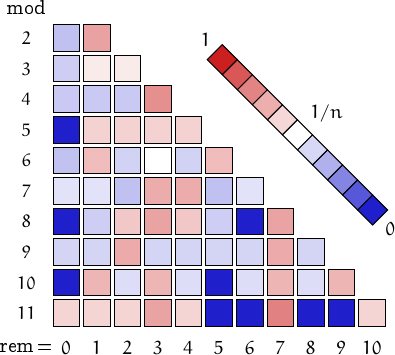The Lucas numbers up to 1015 :
1, 2, 3, 4, 7, 11, 18, 29, 47, 76, 123, 199, 322, 521, 843, 1364, 2207, 3571, 5778, 9349, 15127, 24476, 39603, 64079, 103682, 167761, 271443, 439204, 710647, 1149851, 1860498, 3010349, 4870847, 7881196, 12752043, 20633239, 33385282, 54018521, 87403803, 141422324, 228826127, 370248451, 599074578, 969323029, 1568397607, 2537720636, 4106118243, 6643838879, 10749957122, 17393796001, 28143753123, 45537549124, 73681302247, 119218851371, 192900153618, 312119004989, 505019158607, 817138163596, 1322157322203, 2139295485799, 3461452808002, 5600748293801, 9062201101803, 14662949395604, 23725150497407, 38388099893011, 62113250390418, 100501350283429, 162614600673847, 263115950957276, 425730551631123, 688846502588399.
Distribution of the remainders when the numbers in this family are divided by n=2, 3,..., 11. (I took into account 100000 values, from 1 to 5.8⋅1020898).
| n\r | 0 | 1 | |||||||||
|---|---|---|---|---|---|---|---|---|---|---|---|
| 2 | 33333 | 66667 | 2 | ||||||||
| 3 | 25000 | 37500 | 37500 | 3 | |||||||
| 4 | 16667 | 16667 | 16666 | 50000 | 4 | ||||||
| 5 | 0 | 25000 | 25000 | 25000 | 25000 | 5 | |||||
| 6 | 8333 | 24999 | 12499 | 16667 | 12501 | 25001 | 6 | ||||
| 7 | 12500 | 12500 | 6250 | 25000 | 25000 | 6250 | 12500 | 7 | |||
| 8 | 0 | 8334 | 16666 | 25000 | 16667 | 8333 | 0 | 25000 | 8 | ||
| 9 | 8333 | 8334 | 20834 | 8333 | 8334 | 8333 | 8334 | 20832 | 8333 | 9 | |
| 10 | 0 | 16667 | 8333 | 16667 | 8334 | 0 | 8333 | 16667 | 8333 | 16666 | 10 |
| 11 | 10000 | 10000 | 10000 | 20000 | 10000 | 0 | 0 | 30000 | 0 | 0 | 10000 |
A pictorial representation of the table above

Imagine to divide the members of this family by a number n and compute the remainders. Should they be uniformly distributed, each remainder from 0 to n-1 would be obtained in about (1/n)-th of the cases. This outcome is represented by a white square. Reddish (resp. bluish) squares represent remainders which appear more (resp. less) frequently than 1/n.
e-mail: info -at- numbersaplenty.com • Privacy notice • engine limits